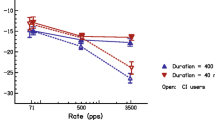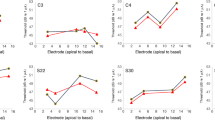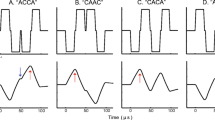Abstract
Recent behavioral studies have suggested that the human auditory nerve of cochlear implant (CI) users is mainly excited by the positive (anodic) polarity. Those findings were only obtained using asymmetric pseudomonophasic (PS) pulses where the effect of one phase was measured in the presence of a counteracting phase of opposite polarity, longer duration, and lower amplitude than the former phase. It was assumed that only the short high-amplitude phase was responsible for the excitation. Similarly, it has been shown that electrically evoked compound action potentials could only be obtained in response to the anodic phases of asymmetric pulses. Here, experiment 1 measured electrically evoked auditory brainstem responses to standard symmetric, PS, reversed pseudomonophasic, and reversed pseudomonophasic with inter-phase gap (6 ms) pulses presented for both polarities. Responses were time locked to the short high-amplitude phase of asymmetric pulses and were smaller, but still measurable, when that phase was cathodic than when it was anodic. This provides the first evidence that cathodic stimulation can excite the auditory system of human CI listeners and confirms that this stimulation is nevertheless less effective than for the anodic polarity. A second experiment studied the polarity sensitivity at different intensities by means of a loudness balancing task between pseudomonophasic anodic (PSA) and pseudomonophasic cathodic (PSC) stimuli. Previous studies had demonstrated greater sensitivity to anodic stimulation only for stimuli producing loud percepts. The results showed that PSC stimuli required higher amplitudes than PSA stimuli to reach the same loudness and that this held for current levels ranging from 10 to 100 % of the dynamic range.














Similar content being viewed by others
References
Andrieu C, De Freitas N, Doucet A et al (2003) An introduction to MCMC for machine learning. Mach Learn 50:5–43
Baayen RH (2012) languageR: Data sets and functions with “Analyzing Linguistic Data: A practical introduction to statistics”
Baayen R, Davidson D, Bates D (2008) Mixed-effects modeling with crossed random effects for subjects and items. J Mem Lang 59:390–412
Bahmer A, Polak M, Baumann U (2010) Recording of electrically evoked auditory brainstem responses after electrical stimulation with biphasic, triphasic and precision triphasic pulses. Hear Res 259:75–85
Bal R, Baydas G (2009) Electrophysiological properties of octopus neurons of the cat cochlear nucleus: an in vitro study. J Assoc Res Otolaryngol 10:281–293
Bal R, Green GGR, Rees A et al (2002) Firing patterns of inferior colliculus neurons-histology and mechanism to change firing patterns in rat brain slices. Neurosci Lett 317:42–46
Banks MI, Smith PH (1992) Intracellular recordings from neurobiotin-labeled cells in brain slices of the rat medial nucleus of the trapezoid body. J Neurosci 12:2819–2837
Basser PJ, Roth BJ (2000) New currents in electrical stimulation of excitable tissues. Annu Rev Biomed Eng 2:377–397
Bates D, Maechler M, Bolker B (2012) lme4: linear mixed-effects models using S4 classes
Bonnet RM, Boermans PBM, Avenarius OF et al (2012) Effects of pulse width, pulse rate and paired electrode stimulation on psychophysical measures of dynamic range and speech recognition in cochlear implants. Ear Hear 33:489–496
Briaire JJ, Frijns JHM (2005) Unraveling the electrically evoked compound action potential. Hear Res 205:143–156
Brown MC (1994) The antidromic compound action potential of the auditory nerve. J Neurophysiol 71:1826–1834
Brown CJ, Hughes ML, Luk B et al (2000) The relationship between EAP and EABR thresholds and levels used to program the nucleus 24 speech processor: data from adults. Ear Hear 21:151–163
Carlyon RP, van Wieringen A, Deeks JM et al (2005) Effect of inter-phase gap on the sensitivity of cochlear implant users to electrical stimulation. Hear Res 205:210–224
Carney LH (1990) Sensitivities of cells in anteroventral cochlear nucleus of cat to spatiotemporal discharge patterns across primary afferents. J Neurophysiol 64:437–456
Cohen LT (2009) Practical model description of peripheral neural excitation in cochlear implant recipients: 5. refractory recovery and facilitation. Hear Res 248:1–14
Davids T, Valero J, Papsin BC et al (2008) Effects of stimulus manipulation on electrophysiological responses of pediatric cochlear implant users. Part II: rate effects. Hear Res 244:15–24
Debruyne F (1986) Influence of age and hearing loss on the latency shifts of the auditory brainstem response as a result of increased stimulus rate. Audiology 25:101–106
R Development Core Team (2011) R: A language and environment for statistical computing. Foundation for Statistical Computing, Vienna
Don M, Elberling C (1994) Evaluating residual background noise in human auditory brain-stem responses. J Acoust Soc Am 96:2746–2757
Elberling C, Don M (1984) Quality estimation of averaged auditory brainstem responses. Scand Audiol 13:187–197
Elberling C, Wahlgreen O (1985) Estimation of auditory brainstem response, ABR, by means of Bayesian inference. Scand Audiol 14:89–96
Fayad JN, Linthicum FH (2006) Multichannel cochlear implants: relation of histopathology to performance. Laryngoscope 116:1310–1320
Fifer RC, Novak MA (1990) Myogenic influences on the electrical auditory brainstem response (EABR) in humans. Laryngoscope 100:1180–1184
Frijns JHM, de Snoo SL, ten Kate JH (1996) Spatial selectivity in a rotationally symmetric model of the electrically stimulated cochlea. Hear Res 95:33–48
Golding NL, Robertson D, Oertel D (1995) Recordings from slices indicate that octopus cells of the cochlear nucleus detect coincident firing of auditory nerve fibers with temporal precision. J Neurosci 15:3138–3153
Gordon KA, Valero J, van Hoesel R et al (2008) Abnormal timing delays in auditory brainstem responses evoked by bilateral cochlear implant use in children. Otol Neurotol 29:193–198
Hay-McCutcheon MJ, Brown CJ, Clay KS et al (2002) Comparison of electrically evoked whole-nerve action potential and electrically evoked auditory brainstem response thresholds in nucleus CI24R cochlear implant recipients. J Am Acad Audiol 13:416–427
Hinojosa R, Marion M (1983) Histopathology of profound sensorineural deafness. Ann N Y Acad Sci 405:459–484
Hofmann M, Wouters J (2010) Electrically evoked auditory steady state responses in cochlear implant users. J Assoc Res Otolaryngol 11:267–282
Jiang ZD, Wu YY, Zheng WS et al (1991) The effect of click rate on latency and interpeak interval of the brain-stem auditory evoked potentials in children from birth to 6 years. Electroencephalogr Clin Neurophysiol 80:60–64
Joris PX, Carney LH, Smith PH et al (1994a) Enhancement of neural synchronization in the anteroventral cochlear nucleus. I. Responses to tones at the characteristic frequency. J Neurophysiol 71:1022–1036
Joris PX, Smith PH, Yin TC (1994b) Enhancement of neural synchronization in the anteroventral cochlear nucleus. II. Responses in the tuning curve tail. J Neurophysiol 71:1037–1051
Joris PX, Schreiner CE, Rees A (2004) Neural processing of amplitude modulated sounds. Physiol Rev 84:541–577
Klop WMC, Hartlooper A, Briaire JJ et al (2004) A new method for dealing with the stimulus artefact in electrically evoked compound action potential measurements. Acta oto-laryngol 124:137–143
Koles ZJ, Rasminsky M (1972) A computer simulation of conduction in demyelinated nerve fibres. J Physiol 227:351–364
Krueger C, Tian L (2004) A comparison of the general linear mixed model and repeated measures ANOVA using a dataset with multiple missing data points. Biol Res Nurs 6:151–157
Laneau J, Boets B, Moonen M et al (2005) A flexible auditory research platform using acoustic or electric stimuli for adults and young children. J Neurosci Methods 142:131–136
Legatt AD (2002) Mechanisms of intraoperative brainstem auditory evoked potential changes. J Clin Neurophysiol 19:396–408
Liberman MC, Oliver ME (1984) Morphometry of intracellularly labeled neurons of the auditory nerve: correlations with functional properties. J Comp Neurol 223:163–176
Macherey O, van Wieringen A, Carlyon RP et al (2006) Asymmetric pulses in cochlear implants: effects of pulse shape, polarity, and rate. J Assoc Res Otolaryngol 7:253–266
Macherey O, Carlyon RP, van Wieringen A et al (2008) Higher sensitivity of human auditory nerve fibers to positive electrical currents. J Assoc Res Otolaryngol 9:241–251
Macherey O, van Wieringen A, Carlyon RP et al (2010) Forward-masking patterns produced by symmetric and asymmetric pulse shapes in electric hearing. J Acoust Soc Am 127:326–338
Macherey O, Deeks JM, Carlyon RP (2011) Extending the limits of place and temporal pitch perception in cochlear implant users. J Assoc Res Otolaryngol 12:233–251
McFadden SL, Ding D, Jiang H et al (2004) Time course of efferent fiber and spiral ganglion cell degeneration following complete hair cell loss in the chinchilla. Brain Res 997:40–51
McKay CM, Henshall KR (2003) The perceptual effects of interphase gap duration in cochlear implant stimulation. Hear Res 181:94–99
McKay CM, McDermott HJ (1999) The perceptual effects of current pulse duration in electrical stimulation of the auditory nerve. J Acoust Soc Am 106:998–1009
Miller AL, Morris DJ, Pfingst BE (1997) Interactions between pulse separation and pulse polarity order in cochlear implants. Hear Res 109:21–33
Miller CA, Abbas PJ, Rubinstein JT et al (1998) Electrically evoked compound action potentials of guinea pig and cat: responses to monopolar, monophasic stimulation. Hear Res 119:142–154
Miller AL, Smith DW, Pfingst BE (1999a) Across-species comparisons of psychophysical detection thresholds for electrical stimulation of the cochlea: II. Strength-duration functions for single, biphasic pulses. Hear Res 135:47–55
Miller CA, Abbas PJ, Rubinstein JT (1999b) An empirically based model of the electrically evoked compound action potential. Hear Res 135:1–18
Miller CA, Abbas PJ, Robinson BK et al (1999c) Electrically evoked single-fiber action potentials from cat: responses to monopolar, monophasic stimulation. Hear Res 130:197–218
Miller CA, Abbas PJ, Robinson BK (2001) Response properties of the refractory auditory nerve fiber. J Assoc Res Otolaryngol 2:216–232
Miller CA, Abbas PJ, Hay-McCutcheon MJ et al (2004) Intracochlear and extracochlear ECAPs suggest antidromic action potentials. Hear Res 198:75–86
Mino H, Rubinstein JT, Miller CA et al (2004) Effects of electrode-to-fiber distance on temporal neural response with electrical stimulation. IEEE Trans Bio-med Eng 51:13–20
Møller AR, Jho HD, Yokota M et al (1995) Contribution from crossed and uncrossed brainstem structures to the brainstem auditory evoked potentials: a study in humans. Laryngoscope 105:596–605
Moon AK, Zwolan TA, Pfingst BE (1993) Effects of phase duration on detection of electrical stimulation of the human cochlea. Hear Res 67:166–178
Morsnowski A, Charasse B, Collet L et al (2006) Measuring the refractoriness of the electrically stimulated auditory nerve. Audiol Neurootol 11:389–402
Nadol JB (1997) Patterns of neural degeneration in the human cochlea and auditory nerve: implications for cochlear implantation. Otolaryngol Head Neck Surg 117:220–228
Nadol JB, Shiao JY, Burgess BJ et al (2001) Histopathology of cochlear implants in humans. Ann Otol Rhinol Laryngol 110:883–891
Newman AJ, Tremblay A, Nichols ES et al (2011) The influence of language proficiency on lexical semantic processing in native and late learners of English. J Cogn Neurosci 1–18
Oertel D (1983) Synaptic responses and electrical properties of cells in brain slices of the mouse anteroventral cochlear nucleus. J Neurosci 3:2043–2053
Pfingst BE, DeHaan DR, Holloway LA (1991) Stimulus features affecting psychophysical detection thresholds for electrical stimulation of the cochlea. I: Phase duration and stimulus duration. J Acoust Soc Am 90:1857–1866
Prado-Guitierrez P, Fewster LM, Heasman JM et al (2006) Effect of interphase gap and pulse duration on electrically evoked potentials is correlated with auditory nerve survival. Hear Res 215:47–55
Ranck JB (1975) Which elements are excited in electrical stimulation of mammalian central nervous system: a review. Brain Res 98:417–440
Rask-Andersen H, Tylstedt S, Kinnefors A et al (2000) Synapses on human spiral ganglion cells: a transmission electron microscopy and immunohistochemical study. Hear Res 141:1–11
Rattay F (1986) Analysis of models for external stimulation of axons. IEEE Trans Bio-med Eng 33:974–977
Rattay F (1999) The basic mechanism for the electrical stimulation of the nervous system. Neuroscience 89:335–346
Rattay F, Lutter P, Felix H (2001) A model of the electrically excited human cochlear neuron. I. Contribution of neural substructures to the generation and propagation of spikes. Hear Res 153:43–63
Reilly JP, Freeman VT, Larkin WD (1985) Sensory effects of transient electrical stimulation-evaluation with a neuroelectric model. IEEE Trans Biomed Eng 32:1001–1011
Rubinstein JT (1993) Axon termination conditions for electrical stimulation. IEEE Trans Bio-med Eng 40:654–663
Shepherd RK, Hardie N (2001) Deafness-induced changes in the auditory pathway: implications for cochlear implants. Audiol Neuro-Otol 6:305–318
Shepherd RK, Javel E (1999) Electrical stimulation of the auditory nerve: II. Effect of stimulus waveshape on single fibre response properties. Hear Res 130:171–188
Silva I (2009) Estimation of post average SNR from evoked responses under nonstationary noise. IEEE Trans Biomed Eng 56:2123
Sly DJ, Heffer LF, White MW et al (2007) Deafness alters auditory nerve fibre responses to cochlear implant stimulation. Eur J Neurosci 26:510–522
Smit JE, Hanekom T, van Wieringen A et al (2010) Threshold predictions of different pulse shapes using a human auditory nerve fibre model containing persistent sodium and slow potassium currents. Hear Res 269:12–22
Smith PH (1995) Structural and functional differences distinguish principal from nonprincipal cells in the guinea pig MSO slice. J Neurophysiol 73:1653–1667
Spoendlin H, Schrott A (1989) Analysis of the human auditory nerve. Hear Res 43:25–38
Tasaki I (1955) New measurements of the capacity and the resistance of the myelin sheath and the nodal membrane of the isolated frog nerve fiber. Am J Physiol 181:639–650
Tavartkiladze GA, Potalova LA, Kruglov AV et al (2000) Effect of stimulation parameters on electrically evoked auditory brainstem responses. Acta oto-laryngol 120:214–217
Tremblay A (2012) LMERConvenienceFunctions: a suite of functions to back-fit fixed effects and forward-fit random effects, as well as other miscellaneous functions
Undurraga JA, van Wieringen A, Carlyon RP et al (2010) Polarity effects on neural responses of the electrically stimulated auditory nerve at different cochlear sites. Hear Res 269:146–161
Undurraga JA, Carlyon RP, Macherey O et al (2012) Spread of excitation varies for different electrical pulse shapes and stimulation modes in cochlear implants. Hear Res 290:21–36
Van Wieringen A, Carlyon RP, Laneau J et al (2005) Effects of waveform shape on human sensitivity to electrical stimulation of the inner ear. Hear Res 200:73–86
Van Wieringen A, Carlyon RP, Macherey O et al (2006) Effects of pulse rate on thresholds and loudness of biphasic and alternating monophasic pulse trains in electrical hearing. Hear Res 220:49–60
Wierda SM, van Rijn H, Taatgen NA et al (2010) Distracting the mind improves performance: an ERP Study. PLoS One 5:e15024
Wu SH (1999) Physiological properties of neurons in the ventral nucleus of the lateral lemniscus of the rat: intrinsic membrane properties and synaptic responses. J Neurophysiol 81:2862–2874
Wu SH, Fu XW (1998) Glutamate receptors underlying excitatory synaptic transmission in the rat’s lateral superior olive studied in vitro. Hear Res 122:47–59
Wu SH, Oertel D (1984) Intracellular injection with horseradish peroxidase of physiologically characterized stellate and bushy cells in slices of mouse anteroventral cochlear nucleus. J Neurosci 4:1577–1588
Zeng FG, Galvin JJ, Zhang C (1998) Encoding loudness by electric stimulation of the auditory nerve. Neuroreport 9:1845–1848
Zhao M, Wu SH (2001) Morphology and physiology of neurons in the ventral nucleus of the lateral lemniscus in rat brain slices. J Comp Neurol 433:255–271
Zhou R, Abbas PJ, Assouline JG (1995) Electrically evoked auditory brainstem response in peripherally myelin-deficient mice. Hear Res 88:98–106
Acknowledgments
This research is supported by the OT grant from the Research Council of the University of Leuven (OT/07/056) and is approved by the Local Research Ethics Committee of the University of Leuven/UZ Leuven.
Author information
Authors and Affiliations
Corresponding author
Rights and permissions
About this article
Cite this article
Undurraga, J.A., Carlyon, R.P., Wouters, J. et al. The Polarity Sensitivity of the Electrically Stimulated Human Auditory Nerve Measured at the Level of the Brainstem. JARO 14, 359–377 (2013). https://doi.org/10.1007/s10162-013-0377-0
Received:
Accepted:
Published:
Issue Date:
DOI: https://doi.org/10.1007/s10162-013-0377-0




